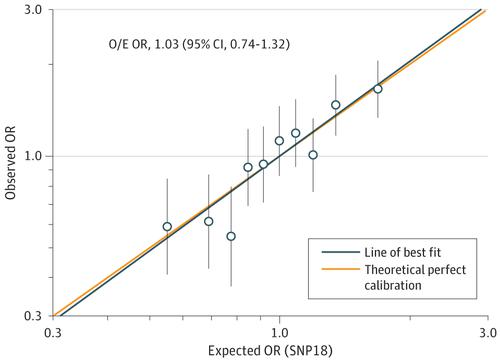JAMA Oncology ( IF 22.5 ) Pub Date : 2018-04-01 , DOI: 10.1001/jamaoncol.2017.4881 Elke M van Veen 1 , Adam R Brentnall 2 , Helen Byers 1 , Elaine F Harkness 3, 4, 5 , Susan M Astley 3, 4, 5, 6 , Sarah Sampson 3 , Anthony Howell 3, 6, 7 , William G Newman 1, 6, 8 , Jack Cuzick 2 , D Gareth R Evans 1, 3, 6, 7, 8

|
Importance Single-nucleotide polymorphisms (SNPs) have demonstrated an association with breast cancer susceptibility, but there is limited evidence on how to incorporate them into current breast cancer risk prediction models.
Objective To determine whether a panel of 18 SNPs (SNP18) may be used to predict breast cancer in combination with classic risk factors and mammographic density.
Design, Setting, and Participants This cohort study enrolled a subcohort of 9363 women, aged 46 to 73 years, without a previous breast cancer diagnosis from the larger prospective cohort of the PROCAS study (Predicting Risk of Cancer at Screening) specifically to evaluate breast cancer risk-assessment methods. Enrollment took place from October 2009 through June 2015 from multiple population-based screening centers in Greater Manchester, England. Follow-up continued through January 5, 2017.
Exposures Genotyping of 18 SNPs, visual-assessment percentage mammographic density, and classic risk assessed by the Tyrer-Cuzick risk model from a self-completed questionnaire at cohort entry.
Main Outcomes and Measures The predictive ability of SNP18 for breast cancer diagnosis (invasive and ductal carcinoma in situ) was assessed using logistic regression odds ratios per interquartile range of the predicted risk.
Results A total of 9363 women were enrolled in this study (mean [range] age, 59 [46-73] years). Of these, 466 were found to have breast cancer (271 prevalent; 195 incident). SNP18 was similarly predictive when unadjusted or adjusted for mammographic density and classic factors (odds ratios per interquartile range, respectively, 1.56; 95% CI, 1.38-1.77 and 1.53; 95% CI, 1.35-1.74), with observed risks being very close to expected (adjusted observed-to-expected odds ratio, 0.98; 95% CI, 0.69-1.28). A combined risk assessment indicated 18% of the subcohort to be at 5% or greater 10-year risk, compared with 30% of all cancers, 35% of interval-detected cancers, and 42% of stage 2+ cancers. In contrast, 33% of the subcohort were at less than 2% risk but accounted for only 18%, 17%, and 15% of the total, interval, and stage 2+ breast cancers, respectively.
Conclusions and Relevance SNP18 added substantial information to risk assessment based on the Tyrer-Cuzick model and mammographic density. A combined risk is likely to aid risk-stratified screening and prevention strategies.
中文翻译:

使用单核苷酸多态性和乳房 X 光密度加上经典风险因素进行乳腺癌风险预测
重要性单核苷酸多态性 (SNP) 已被证明与乳腺癌易感性相关,但关于如何将其纳入当前乳腺癌风险预测模型的证据有限。
目的确定 18 个单核苷酸多态性 (SNP18) 组合是否可用于结合经典危险因素和乳房 X 光密度来预测乳腺癌。
设计、设置和参与者该队列研究纳入了 PROCAS 研究(筛查时预测癌症风险)较大前瞻性队列中 9363 名年龄在 46 至 73 岁之间、之前没有乳腺癌诊断记录的女性子队列,专门用于评估乳腺癌风险评估方法。 2009 年 10 月至 2015 年 6 月期间,英格兰大曼彻斯特的多个人口筛查中心进行了招募。随访持续至2017年1月5日。
18 个 SNP 的暴露基因分型、视觉评估百分比乳房 X 光密度以及通过 Tyrer-Cuzick 风险模型根据队列入组时自行填写的问卷评估的经典风险。
主要结果和措施使用预测风险的每个四分位数范围的逻辑回归比值比评估 SNP18 对乳腺癌诊断(浸润性和导管原位癌)的预测能力。
结果共有 9363 名女性参与了本研究(平均[范围]年龄,59[46-73]岁)。其中,466 人被发现患有乳腺癌(271 人为乳腺癌;195 人为乳腺癌患者)。当未调整或调整乳房 X 光密度和经典因素时(每个四分位数范围的比值比分别为 1.56;95% CI,1.38-1.77 和 1.53;95% CI,1.35-1.74),SNP18 具有类似的预测性,观察到的风险非常接近与预期一致(调整后的观察到预期比值比,0.98;95% CI,0.69-1.28)。综合风险评估表明,18% 的亚队列的 10 年风险为 5% 或更高,而所有癌症的这一比例为 30%,间隔检测的癌症为 35%,2 期以上癌症为 42%。相比之下,33% 的亚组风险低于 2%,但分别仅占总乳腺癌、间期乳腺癌和 2+ 期乳腺癌的 18%、17% 和 15%。
结论和相关性SNP18 为基于 Tyrer-Cuzick 模型和乳房 X 光密度的风险评估添加了大量信息。综合风险可能有助于风险分层筛查和预防策略。











































 京公网安备 11010802027423号
京公网安备 11010802027423号